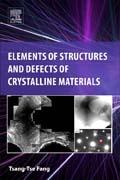
Structures and Defects of Crystalline Materials has been written to cover not only the fundamental principles behind structures and defects but also to provide deep insights into understanding the relationships of properties, defect chemistry, and the processing of the concerned materials. The book has been divided into two parts. Part 1 is made up of three chapters which deal with the structures while Part II covers defects. Since the knowledge of the electron configuration of elements is necessary for understanding the nature of chemical bonding, it is discussed in the opening chapter. This is followed by Chapter 2 which describes the bonding formation within the crystal structures of varied materials, wherein the formation energy and mechanism of covalent bonding have been updated and the potential well concept has been established to correlate with the material properties. Chapter 3 introduces how the material's structure is formed. In view of the importance of the effects of the structure distortion on the material properties due to the fields, the related topics have been included in section 3.4. Moreover, several materials still under intensive investigation have been illustrated to provide deep insights into understanding the effects of the relationships of processing, structures, and defects on the material properties. The defects of materials are explored in Part II. Chapter 4 deals with the point defects of metal and ceramics. Chapter 5 essentially covers the fundamentals of the characteristics of dislocations, wherein physics and the atomic mechanics of several issues have been described in detail. In view of the significant influence of the morphologies including size, shape, and distribution of grains and phases on the microstructure evolution and in turn the properties of materials, the final chapter focuses on the fundamentals of interface energies including single phase (grain) boundary and interphase boundary, wettability determining the morphologies of phases, and the change of surface stress at curved surface leading to the kinetic processes like Ostwald ripening and sintering. The distinction between surface energy, surface tension, and surface stress of liquids and solids in terms of atomic viewpoint is updated. This book will appeal to both materials scientists and engineers, as well as individuals who are in need of a good foundational text on the subject. Discusses the relationship between properties, defect chemistry and the processing of materialsPresents coverage of the fundamental principles behind structures and defectsIncludes information on two-dimensional and three-dimensional imperfections in solids INDICE: Part I Structure of the Crystalline Materials 1. The electron configuration of atoms 2. Bonding within crystal structures 3. The structures of crystalline crystals Part II Defects of Crystalline Materials 4. Point defects in crystalline materials 5. Line defects in crystalline solids 6. Two-dimensional (interfaces) and three-dimensional (second phases) imperfections in solids
- ISBN: 978-0-12-814268-4
- Editorial: Elsevier
- Encuadernacion: Rústica
- Páginas: 288
- Fecha Publicación: 07/01/2018
- Nº Volúmenes: 1
- Idioma: Inglés
